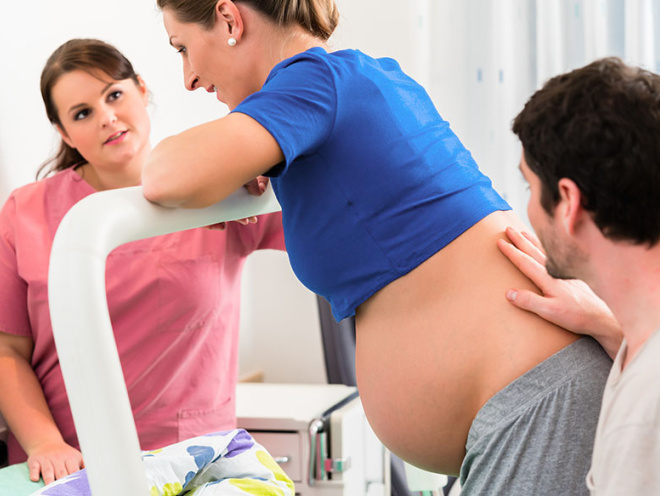Whether you’re hoping to use solely self-help techniques or want the option of drugs, it’s useful to know what pain relief is available in hospital…
If you have your baby in hospital, you’ll usually have access to a wide range of pain relief choices, including epidurals (NHS, 2022). But that doesn’t mean you have to use all of them.
It’s fine to keep your options open until the birth is actually happening. You can then decide what you need and want.
You can use the NHS Maternity services search to find the maternity units that are near to you. Some units will have details online of the pain relief options that they offer. Your midwife should also be able to answer questions about your local units. You might be able to view tours online or arrange to visit the unit.
Here is some info about the different types of pain relief available when you’re admitted in active labour. For more detail, you can click through to our articles about each form of pain relief.
If you’re not admitted and you’re going to be sent home to wait a little longer, or you’re admitted but not yet in strong labour, you might be offered milder opioids such as oral morphine.
Self-help techniques
As well as the more pharmacological methods, everyone in labour will use self-help techniques before or alongside other methods. You could try:
- switching positions
- kneeling, walking around, rocking backwards and forwards
- swaying, dancing and circling hips
- focusing on breathing out very slowly, panting or blowing
- bringing a partner, friend or relative with you to support you (see our article about doulas for how effective this can be)
- making sounds, e.g. singing, moaning and humming
- distracting yourself with TV or music
- a warm bath or shower
- getting your birth partner to give you a massage
- pregnancy yoga techniques
- any other relaxation techniques that help you feel more in control and reduce anxiety. (NHS, 2020)
Some self-help techniques, like distraction, might help you in the early stages. Other techniques like warm water, movement and focusing on your breathing could be useful all the way along (Smith et al, 2006; Laurence et al, 2009; Cluett et al, 2018).
Alternative methods
You could also use alternative therapies like:
- acupuncture
- acupressure, which can provide significant pain relief during the first stage of labour (Raana and Fan, 2020)
- hypnotherapy or hypnobirthing. Women using hypnosis may be less likely to use pharmacological pain relief (Madden et al, 2016), and may have a better birth experience with less fear, pain and anxiety (Downe et al, 2015; Catsaros and Wendland, 2020)
- aromatherapy
- homeopathy
- reflexology.
Just be aware that you’ll need to arrange these therapies in advance, e.g. booking classes or a therapist to be with you during labour (OAA, 2022).
TENS (transcutaneous electrical nerve stimulation)
TENS is a machine that passes a gentle electrical current through pads on your back (OAA, 2022). It is thought to be most useful at the beginning of labour, particularly for backache. So you could use it at home and during your journey to the place of birth.
TENS works by creating a tingling sensation that some people find reduces their pain. You control the strength of the current yourself and it has no side effects (OAA, 2022).
There’s no guarantee your hospital will have TENS machines. So you might want to consider buying or hiring one in advance if you want to use TENS.
Pethidine and other injected opioides
Opioids relax you and may make you feel sleepy or confused. They could be helpful in the early stages of labour to help you get some rest.
Opioids all work in a similar way. The ones commonly used on labour wards include morphine, pethidine and diamorphine (OAA, 2022). They are normally given by injection into your arm or leg. The pain relief starts after about half an hour and lasts a few hours (OAA, 2022).
Some women love the feeling that pethidine gives them and feel less anxious when they’re on it. But others find it doesn’t relieve their pain well and can make them feel nauseous, helpless or out of control (OAA, 2022).
Other downsides are that opioids are thought to be less effective at easing pain in labour than Entonox (OAA, 2022). Opiates can also make your baby sleepier and slower to start breastfeeding.
The best thing to do is to speak to your midwife about whether pethidine or other opiates are something that would be right for you. That way you can go through the pros and cons.
Entonox or gas and air
Entonox is a gas made up of 50% nitrous oxide and 50% oxygen. It is sometimes known as gas and air (OAA, 2022). It is available in the labour room and is inhaled through a mouthpiece or a mask.
It won’t completely take the pain away but it might help to dial down the intensity. Other benefits of gas and air are that:
- it’s quick and simple to take
- there are no risks for your baby, although it can make you a bit lightheaded or sick
- you can use it at any time during labour. (OAA, 2022)
Patient controlled iIntravenous analgesia – remifentanil
Remifentanil is a form of opioid, which you get through a drip into your arm. With remifentanil as a patient controlled iIntravenous analgesia (PCIA), you can control how much you get with the push of a button, so you receive a small dose each time you press (OAA, 2022).
Remifentanil takes effect and wears off quickly and can be used all through labour (NHS, 2020). It can make some people feel sleepy, sick, dizzy or itchy but these effects should go once you stop taking this medication.
Like pethidine, remifentanil can affect the baby’s breathing but this effect usually wears off quickly (NHS, 2020). PCIA is not available in all hospitals so speak to your midwife to find out if it is available at yours (OAA, 2022).
Water
If you plan to have a water birth, ask before you go into labour whether water pools are available at the hospital where you’ll be having your baby. Even if pools are not available, all birthing units should have baths and showers. The opportunity to labour in water is recommended for pain relief (NICE, 2014).
A water birth could help you relax, feel less pain and make it less likely you'd use an epidural (Cluett et al, 2018). Having your baby in water is just as safe as having your baby out of water (Cluett et al, 2018; OAA, 2022). One study found that birthing in water made it less likely that babies would need to be admitted to special care and that women were less likely to have perineal tears (Sidebottom et al, 2020).
Epidural or spinal block
Epidurals are an injection of local anaesthetic and painkiller into your back that stop you feeling pain in certain parts of your body (OAA, 2022). Epidurals are an option for you when you’re giving birth in hospital, if there’s an anaesthetist present and available.
Ask your hospital or midwife whether there are anaesthetists on call day and night for when you’re in labour, or if the times are restricted.
Epidurals are thought to be the most effective form of pain relief for labour and they have no impact on the baby (Anim-Somuah et al, 2018; OAA, 2022). But one in eight times they do not work well enough so women decide they need to use other pain relief as well (OAA, 2022).
The downsides of epidurals are:
- If the anaesthetist is with someone else or in theatre, you will have to wait until they are free for your epidural. This may be frustrating.
- Epidurals can slow down the second stage of labour, which might increase the likelihood of needing forceps or ventouse to assist with the birth.
- Side effects can include low blood pressure, headaches and difficulty passing urine. Serious side effects are possible but extremely rare. (OAA, 2022)
Lower-dose epidural
If it is available, you might prefer a lower dose epidural so you can still move around a bit in labour and have some feeling during the birth. Yet because an epidural can’t be adjusted exactly, a lower dose might mean you’re a bit more uncomfortable during labour.
Chat to your midwife about whether a lower-dose epidural is available in your chosen hospital (OAA, 2022). Some trusts only offer lower-dose epidurals.
Sterile water injections
Some hospitals offer sterile water injections, usually for women experiencing strong back pain in labour (Derry et al, 2012). The injections are painful but, when that pain subsides, they might reduce the pain of contractions for two to three hours (Derry et al, 2012).
Injections can be repeated as often as needed, with no adverse effects (only the administration pain) on the mother or their baby (Martensson et al, 2017).
Studies have found that women say they had a significant reduction in their back pain during labour after having this injection (Martenson et al, 2017; Fouly et al, 2018; Koyucu et al, 2018; Lee et al, 2020). In one study, around a third of women said that their labour pain was halved at 30, 60 and 90 minutes after the injection (Lee et al, 2020).
Some women describe the pain from the injections as being like an insect sting. This might put some women off using this form of pain management in labour (Lee et al, 2017).
Sterile water injections are not widely available despite them being a cheap, easy to administer and potentially effective method of pain relief (Derry et al, 2012; RCM, 2016). NICE do not recommend sterile water injections but this is based on evidence from 2007 (NICE, 2017). This might explain why these injections are not widely available in the UK despite being used regularly in countries such as Sweden and Australia (Lee et al, 2020).
This page was last reviewed in February 2022.
Further information
Our support line offers practical and emotional support with feeding your baby and general enquiries for parents, members and volunteers: 0300 330 0700.
We also offer antenatal courses which are a great way to find out more about birth, labour and life with a new baby.
Make friends with other parents-to-be and new parents in your local area for support and friendship by seeing what NCT activities are happening nearby.
Which? BirthChoiceUK provides information aimed at helping parents make the right choice about where to give birth.
Anim-Somuah M, Smyth RM, Cyna AM, Cuthbert A. (2018) Epidural versus non-epidural or no analgesia for pain management in labour. Cochrane Database Syst Rev. 5(5):CD000331. Available at: https://doi.org/10.1002/14651858.CD000331.pub4
Catsaros S, Wendland J. (2020) Hypnosis-based interventions during pregnancy and childbirth and their impact on women’s childbirth experience: A systematic review. Midwifery. Available at: https://doi.org/10.1016/j.midw.2020.102666
Cluett E, Burns E, Cuthbert A. (2018) Immersion in water in labour and birth. Cochrane Database Syst Rev. 5(5):CD000111. Available at: https://doi.org/10.1002/14651858.CD000111.pub3
Derry S, Straube S, Moore RA, Hancock H, Collins SL. (2012) Intracutaneous or subcutaneous sterile water injection compared with blinded controls for pain management in labour. Cochrane Database Syst Rev. (1):CD009107. Available at: https://doi.org/10.1002/14651858.CD009107.pub2
Downe S, Finlayson K, Melvin C, Spiby H, Ali S, Diggle P, et al. (2015) Self-hypnosis for intrapartum pain management in pregnant nulliparous women: a randomised controlled trial of clinical effectiveness. BJOG. 122(9):1226-1234. Available at: https://doi.org/10.1111/1471-0528.13433
Fouly H, Herdan R, Habib D, Yeh C. (2018) Effectiveness of injecting lower dose subcutaneous water verses saline to relief labor back pain: Randomised controlled trial. European J Midwifery. 2(3). Available at: https://doi.org/10.18332/ejm/85793
Koyucu R, Demirci N, Yumru A, Salman S, Ayanoglu YT, Tosun Y, et al. (2018) Effects of intradermal sterile water injections in women with low back pain in labor: a randomized, controlled, clinical trial. Balkan Med J. 35(2):148‐154. Available at: https://doi.org/10.4274/balkanmedj.2016.0879
Lee N, Kildea S, Stapleton H. (2017) No pain, no gain: the experience of women using sterile water injections. Women Birth. 30(2):153-158. Available at: https://doi.org/10.1016/j.wombi.2016.09.010
Lee N, Gao Y, Collins S, Martensson L, Randall W, Rowe T, Kildea S. (2020) Caesarean delivery rates and analgesia effectiveness following injections of sterile water for back pain in labour: A multicentre, randomised placebo controlled trial. EClinicalMedicine. 25:100447. Available at: https://doi.org/10.1016/j.eclinm.2020.100447
Madden K, Middleton P, Cyna AM, Matthewson M, Jones L. (2016) Hypnosis for pain management during labour and childbirth. Cochrane Database Syst Rev. (5):CD009356. https://doi.org/10.1002/14651858.CD009356.pub3
Martensson LB, Hutton EK, Lee N, Kildea S, Gao Y, Bergh I. (2017) Sterile water injections for childbirth pain: an evidence based guide to practice. Women Birth. 31(5):380-385. Available at: https://doi.org/10.1016/j.wombi.2017.12.001
NICE. (2014) Intrapartum care for healthy women and babies. Clinical Guidance CG190. Available at: https://www.nice.org.uk/guidance/cg190/resources/intrapartum-care-for-h… [Accessed 5th April 2021]
OAA. (2022) FAQs pain relief. Available from: https://www.labourpains.com/FAQ_Pain_Relief [Accessed 2nd February 2022].
RCM. (2016) Introducing sterile water injections as an alternative for pain relief. Available at: https://www.youtube.com/watch?v=FLO2Cn8zEvs [Accessed 26th January 2022].
Sidebottom AC, Vacquier M, Simon K, Wunderlich W, Fontaine P, Dahlgren-Roemmich D, et al (2020). Maternal and neonatal outcomes in hospital-based deliveries with water immersion. Obstetrics Gynecol. 136(4):707-15. Available at: https://doi.org/10.1097/AOG.0000000000003956
Smith A, Collins C, Cyna A, Crowther C. (2006) Complementary and alternative therapies for pain management in labour. Cochrane Database Syst Rev. (4):CD003521 Available at: https://doi.org/10.1002/14651858.CD003521.pub2




